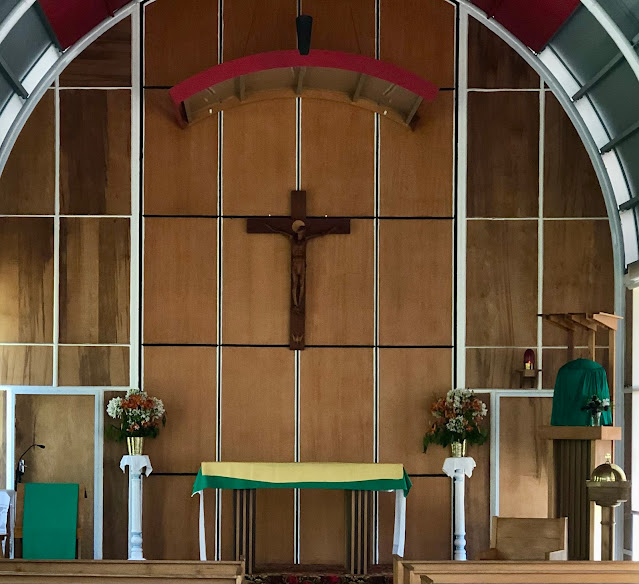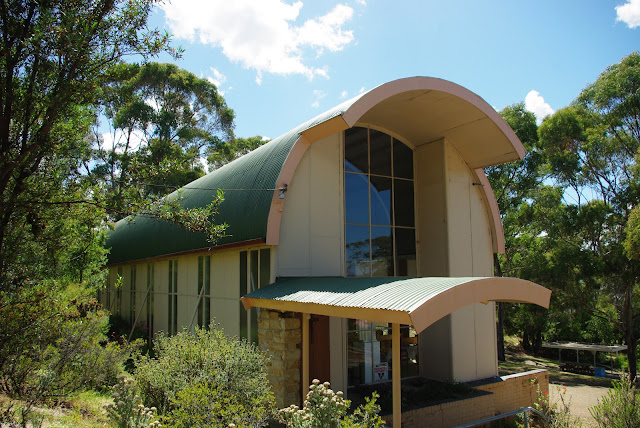No. 1275 - Taroona - St Pius X Catholic Church (1957)
Taroona is located on the western shore of the Derwent River and is an outer southern suburb of Greater Hobart. The name ‘taroona’ is a Mouheneener word for chiton, a marine mollusc found on rocks in the intertidal regions of the foreshore. The name ‘Taroona’ was adopted by Clarendon James Cox Lord for his 18-acre property which he purchased in 1894.
St Pius X Catholic church was designed by architect James Esmond Dorney and is held to be Australia’s first Modernist church. The church was blessed and opened by Archbishop Guilford Young on 26 October 1957.
The first Catholic Mass was held in Taroona’s old public Hall in 1949. In 1953 the Parish of Sandy Bay-Taroona was established which gave momentum to the cause to build a church. By 1956 successful fundraising led by Father J. Halpin resulted in the commissioning of plans for a church on a 2¼ acre bushland site at lower Taroona. Mr F. Ingram was engaged to build the church.
The church was a “healthily modern” building and featured ceiling to floor windows giving a panoramic view of the Derwent River. Archbishop Guilford Young described the building as “admirable in the use of modern materials which captured the new humanity created by Christ and infused with the Holy Spirit”.
Archbishop Young was a pioneer in promoting modern architecture. In a recent article in Architecture Australia, Dr. Stuart King, a senior lecturer in architectural design and history, describes Young’s involvement in the new era of church building in Tasmania:
“Archbishop Guilford Young commenced his episcopate in Hobart in 1955, embarking upon a program of modernisation and reform in the areas of church administration, education, worship and church building. He had a keen interest in architecture, but worked within a context of limited financial resources coupled with a growing demand for new churches. As he consecrated new churches, including Dorney’s Pius X Catholic Church, Young advocated “healthily modern” church architecture.…Young’s interest in modern architecture was allied to an international liturgical reform movement. The goal was to develop an architecture to aid in modernising worship.…The wider discourse posited that the essential function of a church building was to accommodate the performance of the liturgy, and especially the Eucharist, which was understood as an action involving the clergy and the congregation as a community”.
The furnishings of the church also reflected the new era. A carved crucifix above the altar was created by Alan Gelston while a statue of the Virgin Mary was described as a work of art and not “factory rubbish”. Handworked vestments for the church were given by the Good Shepherd Sisters at Mount St. Canice while children from Mount Carmel College presented the church with a set of altar linen.
In 1967 the church narrowly escaped destruction in the massive bushfires that swept across the south of Tasmania. Fires surrounded the church and the roof was pierced by a falling tree. The fire penetrated the church’s foundation structure but miraculously it did not take hold.
St Pius X has featured in Open House Hobart, an free annual architecture program that opens some of Tasmania’s most unique and interesting buildings to the public. The church’s architect, James Henry Esmond Dorney, is remembered for a series of notable Streamline Moderne apartment blocks in Melbourne in the 1930s, and a number of Modernist houses in Tasmania in the 1950s and 60s. Dorney has been credited with bringing Modernism to Tasmania. Dorney was the first twentieth century architect to gain Heritage listing in Victoria. An annual architectural prize is now given in his honour in Tasmania.The Taroona church largely remains in its original form and is a unique example of Dorney’s work.
Sources:
King, Stuart: "A church that projected progressivist ideals in Tasmanian suburbia", Architecture Australia, Volume 108 Issue 3, May/June 2019
Southerwood, W. T. Planting a faith : Hobart's Catholic story in word and picture / [by] W. T. Southerwood [Hobart] 1970
Taroona Historical Group. Taroona, 1808-1986 : farm lands to a garden suburb / written by past and present residents of Taroona Taroona Historical Group [Taroona, Tas.] 1988
Catholic Standard, Friday 22 November 1957, page 1
https://openhousehobart.org/buildings/st-pius-x-church/
St Pius X Catholic church was designed by architect James Esmond Dorney and is held to be Australia’s first Modernist church. The church was blessed and opened by Archbishop Guilford Young on 26 October 1957.
The first Catholic Mass was held in Taroona’s old public Hall in 1949. In 1953 the Parish of Sandy Bay-Taroona was established which gave momentum to the cause to build a church. By 1956 successful fundraising led by Father J. Halpin resulted in the commissioning of plans for a church on a 2¼ acre bushland site at lower Taroona. Mr F. Ingram was engaged to build the church.
The church was a “healthily modern” building and featured ceiling to floor windows giving a panoramic view of the Derwent River. Archbishop Guilford Young described the building as “admirable in the use of modern materials which captured the new humanity created by Christ and infused with the Holy Spirit”.
Archbishop Young was a pioneer in promoting modern architecture. In a recent article in Architecture Australia, Dr. Stuart King, a senior lecturer in architectural design and history, describes Young’s involvement in the new era of church building in Tasmania:
“Archbishop Guilford Young commenced his episcopate in Hobart in 1955, embarking upon a program of modernisation and reform in the areas of church administration, education, worship and church building. He had a keen interest in architecture, but worked within a context of limited financial resources coupled with a growing demand for new churches. As he consecrated new churches, including Dorney’s Pius X Catholic Church, Young advocated “healthily modern” church architecture.…Young’s interest in modern architecture was allied to an international liturgical reform movement. The goal was to develop an architecture to aid in modernising worship.…The wider discourse posited that the essential function of a church building was to accommodate the performance of the liturgy, and especially the Eucharist, which was understood as an action involving the clergy and the congregation as a community”.
The furnishings of the church also reflected the new era. A carved crucifix above the altar was created by Alan Gelston while a statue of the Virgin Mary was described as a work of art and not “factory rubbish”. Handworked vestments for the church were given by the Good Shepherd Sisters at Mount St. Canice while children from Mount Carmel College presented the church with a set of altar linen.
In 1967 the church narrowly escaped destruction in the massive bushfires that swept across the south of Tasmania. Fires surrounded the church and the roof was pierced by a falling tree. The fire penetrated the church’s foundation structure but miraculously it did not take hold.
St Pius X has featured in Open House Hobart, an free annual architecture program that opens some of Tasmania’s most unique and interesting buildings to the public. The church’s architect, James Henry Esmond Dorney, is remembered for a series of notable Streamline Moderne apartment blocks in Melbourne in the 1930s, and a number of Modernist houses in Tasmania in the 1950s and 60s. Dorney has been credited with bringing Modernism to Tasmania. Dorney was the first twentieth century architect to gain Heritage listing in Victoria. An annual architectural prize is now given in his honour in Tasmania.The Taroona church largely remains in its original form and is a unique example of Dorney’s work.
 |
| The church's opening in 1957 - NRM South (Facebook post December 2015) |
.jpg) |
| The old Taroona Public Hall where Anglican services were held in the 1940s and early 1950s. Source: Libraries Tasmania - PH30-1-6816 |
 |
| James Henry Esmond Dorney (1906 - 1991) - https://www.wikitree.com/photo.php/6/62/Dorney-83.jpg |
 |
| Archbishop Sir Guilford Young - source: Archdiocese of Hobart |
King, Stuart: "A church that projected progressivist ideals in Tasmanian suburbia", Architecture Australia, Volume 108 Issue 3, May/June 2019
Southerwood, W. T. Planting a faith : Hobart's Catholic story in word and picture / [by] W. T. Southerwood [Hobart] 1970
Taroona Historical Group. Taroona, 1808-1986 : farm lands to a garden suburb / written by past and present residents of Taroona Taroona Historical Group [Taroona, Tas.] 1988
Catholic Standard, Friday 22 November 1957, page 1
https://openhousehobart.org/buildings/st-pius-x-church/












Comments
Post a Comment